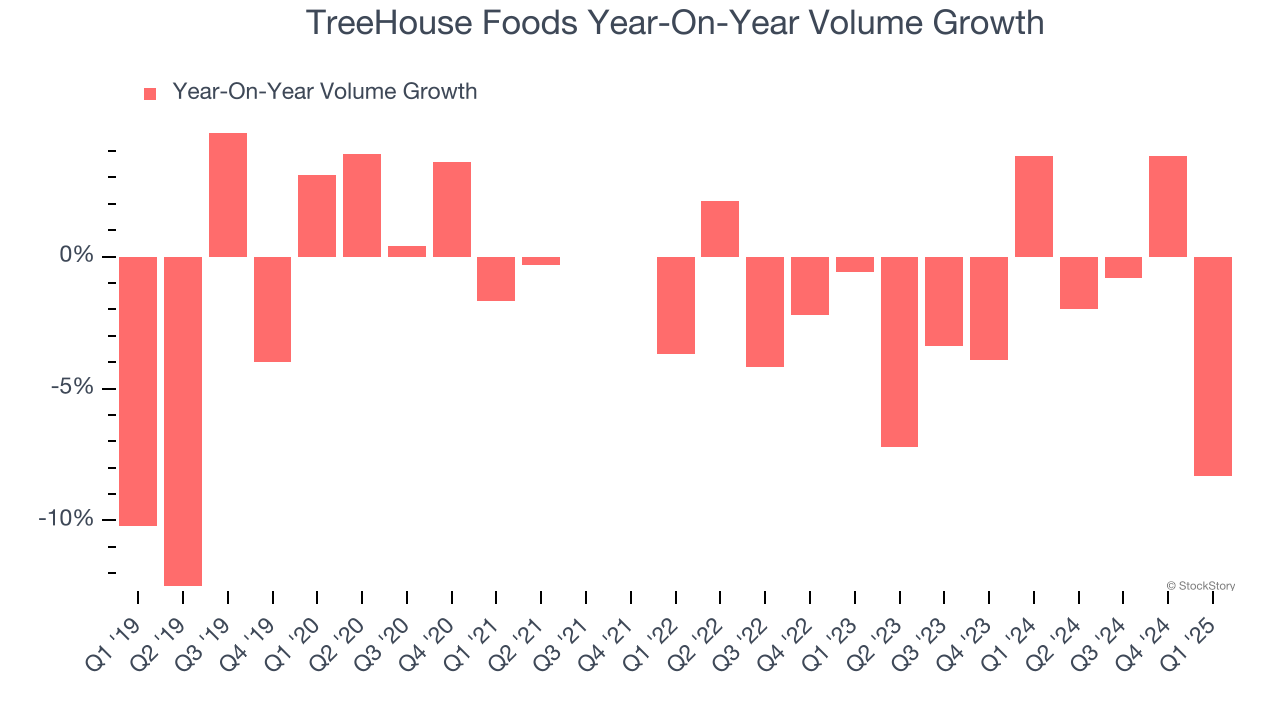
Private label food company TreeHouse Foods (NYSE:THS) met Wall Street’s revenue expectations in Q1 CY2025, but sales fell by 3.5% year on year to $792 million. The company expects next quarter’s revenue to be around $792.5 million, coming in 0.9% above analysts’ estimates. Its non-GAAP profit of $0.03 per share was significantly above analysts’ consensus estimates.
Is now the time to buy TreeHouse Foods? Find out by accessing our full research report, it’s free.
TreeHouse Foods (THS) Q1 CY2025 Highlights:
- Revenue: $792 million vs analyst estimates of $789.6 million (3.5% year-on-year decline, in line)
- Adjusted EPS: $0.03 vs analyst estimates of -$0.16 (significant beat)
- Adjusted EBITDA: $14.3 million vs analyst estimates of $48.46 million (1.8% margin, 70.5% miss)
- The company reconfirmed its revenue guidance for the full year of $3.37 billion at the midpoint
- EBITDA guidance for the full year is $360 million at the midpoint, above analyst estimates of $357 million
- Operating Margin: -0.7%, in line with the same quarter last year
- Free Cash Flow was -$75.3 million compared to -$80.7 million in the same quarter last year
- Organic Revenue fell 3.5% year on year (-7.7% in the same quarter last year)
- Sales Volumes fell 8.3% year on year (3.8% in the same quarter last year)
- Market Capitalization: $1.18 billion
"I am grateful to the entire TreeHouse team for its execution this quarter, which resulted in Adjusted EBITDA that exceeded the upper-end of our guidance range," said Steve Oakland, Chairman, Chief Executive Officer, and President.
Company Overview
Whether it be packaged crackers, broths, or beverages, Treehouse Foods (NYSE:THS) produces a wide range of private-label foods for grocery and food service customers.
Sales Growth
A company’s long-term performance is an indicator of its overall quality. Any business can experience short-term success, but top-performing ones enjoy sustained growth for years.
With $3.33 billion in revenue over the past 12 months, TreeHouse Foods carries some recognizable products but is a mid-sized consumer staples company. Its size could bring disadvantages compared to larger competitors benefiting from better brand awareness and economies of scale.
As you can see below, TreeHouse Foods’s demand was weak over the last three years. Its sales fell by 1.8% annually as consumers bought less of its products.

This quarter, TreeHouse Foods reported a rather uninspiring 3.5% year-on-year revenue decline to $792 million of revenue, in line with Wall Street’s estimates. Company management is currently guiding for flat sales next quarter.
Looking further ahead, sell-side analysts expect revenue to grow 1.7% over the next 12 months. While this projection implies its newer products will catalyze better top-line performance, it is still below the sector average.
Here at StockStory, we certainly understand the potential of thematic investing. Diverse winners from Microsoft (MSFT) to Alphabet (GOOG), Coca-Cola (KO) to Monster Beverage (MNST) could all have been identified as promising growth stories with a megatrend driving the growth. So, in that spirit, we’ve identified a relatively under-the-radar profitable growth stock benefiting from the rise of AI, available to you FREE via this link.
Volume Growth
Revenue growth can be broken down into changes in price and volume (the number of units sold). While both are important, volume is the lifeblood of a successful staples business as there’s a ceiling to what consumers will pay for everyday goods; they can always trade down to non-branded products if the branded versions are too expensive.
To analyze whether TreeHouse Foods generated its growth (or lack thereof) from changes in price or volume, we can compare its volume growth to its organic revenue growth, which excludes non-fundamental impacts on company financials like mergers and currency fluctuations.
Over the last two years, TreeHouse Foods’s average quarterly volumes have shrunk by 2.3%. This isn’t ideal for a consumer staples company, where demand is typically stable. In the context of its 3% average organic sales declines, we can see that most of the company’s losses have come from fewer customers purchasing its products.

In TreeHouse Foods’s Q1 2025, sales volumes dropped 8.3% year on year. This result represents a further deceleration from its historical levels, showing the business is struggling to move its products.
Key Takeaways from TreeHouse Foods’s Q1 Results
We liked that TreeHouse Foods's organic revenue outperformed Wall Street’s estimates. On the other hand, its EBITDA missed significantly and its EBITDA guidance for next quarter fell short of Wall Street’s estimates. Zooming out, we think this was a mixed quarter featuring some areas of strength but also some blemishes. The market seemed to be hoping for more, and the stock traded down 1.1% to $23.16 immediately after reporting.
Is TreeHouse Foods an attractive investment opportunity right now? If you’re making that decision, you should consider the bigger picture of valuation, business qualities, as well as the latest earnings. We cover that in our actionable full research report which you can read here, it’s free.
